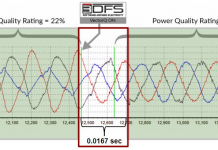Part I: With Smart Grid Brains and Transmission Brawn…
Tom Konrad, CFA
A robust national grid will be essential to achieving high penetration for renewable electricity at reasonable cost, and the companies that can help build it are an essential part of a clean energy portfolio.
Many renewable energy advocates, especially those enchanted by the gigantic potential for solar, think that we can get by with local renewable energy. While it’s a pretty vision, the timing of wind and solar (the only forms of renewable energy that have the potential to produce 100% of our electricity) mean that this could only be achieved with prohibitively costly investment in grid tied energy storage. It makes much more sense to invest in a smarter and more robust grid before making large investments in energy storage.
Diversification of Electricity
There are two aspects of this: managing our energy usage better, which is the province of the smart grid, and interconnecting it better, allowing us to take advantage of the natural variations between both supply and demand in different locations with long distance transmission. In much the same way combining two imperfectly correlated stocks in a portfolio reduces overall risk, connecting two regions with high voltage transmission reduces the overall imbalances between variable supply and variable demand that need to be met with dispatchable generation.
It’s much easier to balance supply and demand over a large area than it is over a small area. On the smallest scale, this is the reason that almost all net zero electricity homes are grid-tied. Although such a home has the capacity to produce all the electricity it needs on an annual basis, the cost of the batteries needed to store the extra electricity produced during sunny summer months for use on long, dark winter nights would be prohibitive. Instead, home owners use the wires connecting them to the local grid as extremely inexpensive virtual storage. Long distance transmission can serve the same function on a much larger scale at a cost of only a fraction of the comparable real storage.
Time and Space
Transmission shifts electric supply in space, while storage shifts electric supply in time, and smart grid technologies shift electric demand in time. Both Smart Grid and Transmission can therefore provide virtual storage, and both do it at a low cost compared to real electricity storage.
Last year saw investors finally take notice of Smart Grid stocks, but transmission has yet to capture their attention (perhaps because many renewable energy aficionados still cling to the dream that we can transition to clean energy sources using just the smart grid and storage.) While such a transition would be physically possible, it would make no more economic sense than putting solar panels on your roof and racks of batteries in your basement in order to cut your connection to your electric utility.
If 2009 was the year investors woke up to the potential of the Smart Grid, 2010 may be the year they begin to see the strong grid.
Part II of this article will look at which Strong Grid stocks are the strongest financially.
DISCLOSURE: None.
DISCLAIMER: The information and trades provided here and in the comments are for informational purposes only and are not a solicitation to buy or sell any of these securities. Investing involves substantial risk and you should evaluate your own risk levels before you make any investment. Past results are not an indication of future performance. Please take the time to read the full disclaimer here.









Better interconnection of power via transmission is important to the smart grid as this article points out. But energy storage does not have to be cost prohibitive. To help hasten the implementation of storage there are currently two bills in Congress proposing tax deductions for use of thermal storage and other storage technologies. Thermal storage, the least expensive of the storage technologies for the smart grid, can delay or eliminate construction of new power plants and transmission lines, making our grid stronger and less costly to change. It does this by generating and storing energy when it is most efficient to do. Creating and transmitting energy in the cool of the night, reduces transmission line losses, thereby making stronger and more efficient use of existing power resources.
In the coming years, the manufacture of thermal energy storage and storage in general will continue to increase. Thermal storage will be the low hanging fruit that will speed up the building of the smart grid.
Electricity storage is subject to physical limits. HVAC based thermal storage is indeed cheap compared to batteries, but still quite expensive compared to long distance transmission, where electricity is stored virtually by effectively allowing one region to borrow and use it during a period of local high demand, and repay the electricity debt later, when the local price is lower.
Thermal storage systems still need a storage medium (even if it’s only water/ice) and an insualted tank to hold the medium. The physical properties of this tank place the lower limit on the per kWh cost of storage.
Technology and price will improve over time, but truly cheap storage is unlikely to appear in a time frame sufficient to deal with Climate change, if it ever appears.
That’s not to say we should not be imporving electricity storage technology, but there are limitations, especially in the next couple decades, that we need to acknowledge if we are going to make intelligent investments.